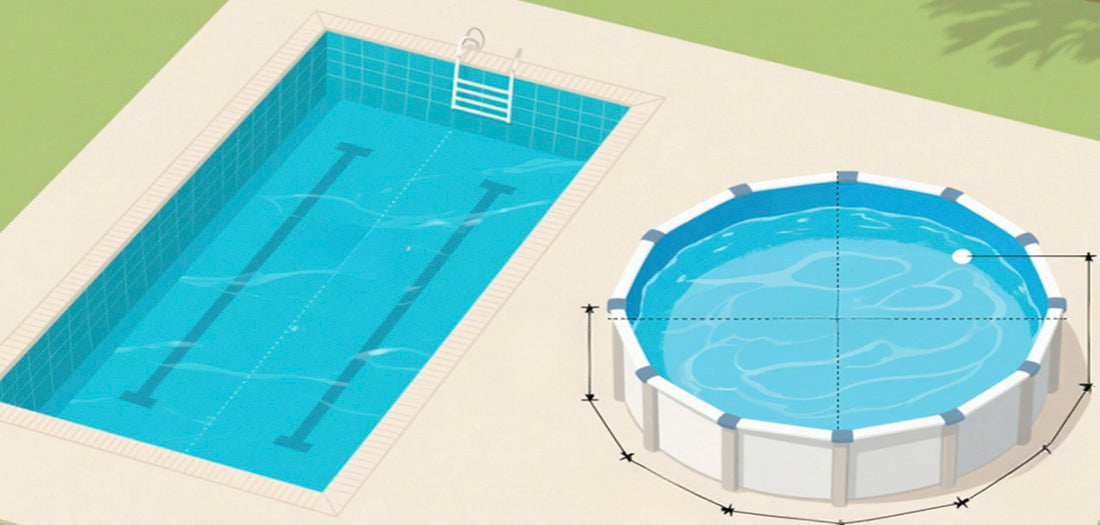
How to Calculate Your Pool’s Water Volume Like a Pro
Share
Ever wondered exactly how much water your pool holds? Whether you're adding chemicals, upgrading equipment, or just curious, knowing your pool’s volume is essential. Use our simple calculator or follow this guide to measure it yourself.
Get an Accurate Measurement
To get the right pool volume, always measure the actual water depth—not just the wall height. Most pools aren’t filled to the brim, so measuring from the top of the waterline ensures accuracy.
For irregularly shaped pools, you might need extra calculations. We’ll walk you through those at the end.
Quick Pool Volume Reference Chart
If your pool is a standard size, use the chart below for a quick estimate. Keep in mind that measuring your pool personally will always yield the most precise results.
Above Ground - 48” Wall Height
|
Above Ground - 52” Wall Height
|
InGround - Average Depth
|
Step-by-Step Pool Volume Calculation
The Basics of Pool Volume Calculation
To determine your pool’s total volume, you’ll first need to calculate the surface area and average depth. Here’s what you need:
Length (L)
Width (W)
Depth (D) or Height (H)
Diameter (d) (for circular pools)
Radius (r) (for circular pools)
Pi (3.14)
For rectangular pools, multiply the length and width for surface area, then incorporate the depth for volume. One cubic foot of water equals 7.5 gallons, so you’ll multiply your cubic foot measurement by 7.5 to get the total volume in gallons.
Pool Volume Calculations by Shape
Rectangular Pool Volume
Your formula will vary based on whether your pool has a consistent depth or multiple depth levels.
✔ Single Depth Pool
Formula: L × W × D × 7.5 = V (gallons)
Example: A 32 ft. x 16 ft. pool with a depth of 4 ft.
32 × 16 × 4 × 7.5 = 15,360 gallons
✔ Sloped Pool (Shallow to Deep End)
First, calculate the average depth: (Shallow Depth + Deep Depth) ÷ 2
Example: If your pool is 3 ft. at the shallow end and 9 ft. at the deep end:
(3 + 9) ÷ 2 = 6 ft. average depth
32 × 16 × 6 × 7.5 = 23,040 gallons
✔ Pool with a Sharp Drop-Off
Treat the shallow and deep sections as separate pools.
Calculate each section’s volume using the constant depth formula, then add the two volumes together for the total pool volume.
Round Pool Volume
For circular pools, use this formula:
Formula: 3.14 × r² × D × 7.5 = V (gallons)
Example: A pool with an 18 ft. diameter (9 ft. radius) and 4 ft. depth:
3.14 × (9 × 9) × 4 × 7.5 = 7,630 gallons
Irregular-Shaped Pool Volume
For pools with non-traditional shapes (like kidney or oval pools), break them down into smaller, simpler shapes (like rectangles or circles). Calculate the volume of each section separately using the appropriate formulas, then sum them to get the total volume.
When to Call a Pool Professional
If your pool shape makes calculations tricky or you want a highly precise measurement, consider hiring a pool expert. Accurate volume measurements are crucial not only for chemical balancing but also for installing new pumps, filters, or heaters.
Keep Your Pool Volume Handy
Knowing your pool’s volume helps you maintain proper chemical levels and keeps your water clean and safe. Keep your final calculations on hand—you’ll refer to them often as a pool owner!
